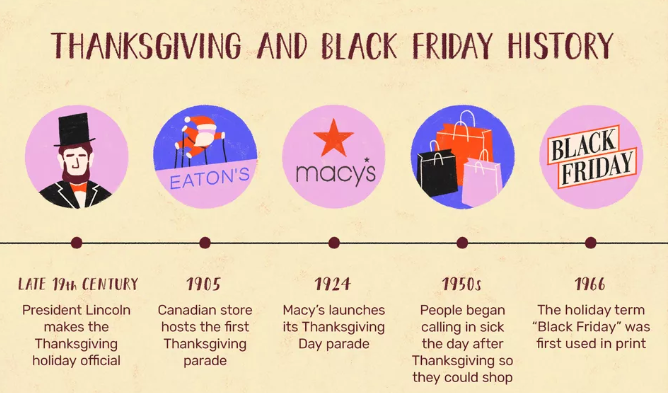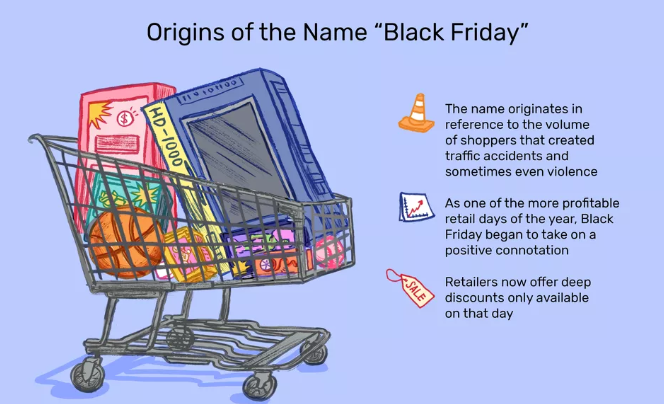Black friday meaning and History(Why Is Black Friday Called Black Friday?)
Black Friday is an informal name for the Friday following Thanksgiving Day in the United States, which is celebrated on the fourth Thursday of November. The day after Thanksgiving has been regarded as the beginning of America’s Christmas shopping season since 1952, although the term “Black Friday” did not become widely used until more recent decades.
The first recorded use of the term “Black Friday” was applied not to holiday shopping but to financial crisis: specifically, the crash of the U.S. gold market on September 24, 1869. Two notoriously ruthless Wall Street financiers, Jay Gould and Jim Fisk, worked together to buy up as much as they could of the nation’s gold, hoping to drive the price sky-high and sell it for astonishing profits. On that Friday in September, the conspiracy finally unraveled, sending the stock market into free-fall and bankrupting everyone from Wall Street barons to farmers.
The most commonly repeated story behind the post-Thanksgiving shopping-related Black Friday tradition links it to retailers. As the story goes, after an entire year of operating at a loss (“in the red”) stores would supposedly earn a profit (“went into the black”) on the day after Thanksgiving, because holiday shoppers blew so much money on discounted merchandise. Though it’s true that retail companies used to record losses in red and profits in black when doing their accounting, this version of Black Friday’s origin is the officially sanctioned—but inaccurate—story behind the tradition.

Black Friday tales
When shops in the US recorded their accounting details by hand, they noted profits in black and losses in red.
It is thought that many shops were “in the red” throughout most of the year but they later “went into the black” the day after Thanksgiving, when shoppers bought a significant amount of discounted merchandise.
In more recent years, an inaccurate rumour circulated, suggesting that Southern plantation owners could buy slaves at a discounted price following Thanksgiving in the 1800s.
Who coined the name Black Friday?
Police officers in Philadelphia were first to link Black Friday to the post-Thanksgiving period in the 1950s. Large crowds of tourists and shoppers came to the city the day after Thanksgiving for the Army-Navy football game, creating chaos, traffic jams and shoplifting opportunities.
Police officers in the city weren’t able to take the day off work and instead had to work long shifts to control the carnage, thus using the term “Black Friday” to refer to it.
As the name spread throughout Philadelphia, some of the city’s merchants and boosters disliked the negative connotations and unsuccessfully tried to change it to “Big Friday”.
Black Friday later became known in print, after an advertisement was published in The American Philatelist magazine in 1966. By the late 1980s, the term was commonly known across the nation and retailers soon linked it to their post-Thanksgiving sales.
Today, Black Friday is the USA’s biggest shopping event of the year, when many shops cut their prices on a range of products, in order to boost profits and officially kick off the festive season.
The US sales phenomenon
Sales in November were popular in the US before the Philadelphia police officers coined the term Black Friday.
The department store Macy’s was the first to advertise post-Thanksgiving shopping in 1924, during their Thanksgiving Day Parade in New York.
The shopping day grew popular throughout the 1930s, although retailers suffered during the Great Depression.
President Franklin D Roosevelt made the decision to move the date of Thanksgiving one week earlier than normal in 1939, in hope that the sales would boost the US economy. Some dubbed this move “Franksgiving”.
After the police officers linked Black Friday to the chaos in Philadelphia, the shopping craze became more widespread in the 1970s and 1980s, with shops attracting huge crowds.
Today, millions of Americans hit the shops and search websites, to look for the best deals; retailers often continue their sales throughout the weekend, concluding with online-only offers on Cyber Monday.
When analysing 80 of the top 100 US online retailers, Adobe Analytics found online spending on Black Friday 2018 reached $6.2 billion, with two billion of this being generated from smartphones.

black friday
The growth of Black Friday in the UK
Online retail giant Amazon introduced the concept to the UK in 2010, promoting a range of discounts and deals to consumers.
In 2013, supermarket Asda, owned by American retailer Walmart, later held its own Black Friday sale – one which resulted in chaos as customers physically fought for televisions and gadgets. Following this, Black Friday has grown significantly throughout the UK, with more and more retailers choosing to hold sale events.
Despite some retailers such as Ikea and Marks and Spencer choosing not to openly join the shopping craze, many retailers have successfully boosted their profits by participating.
In particular, the sales weekend has generated a significant amount of online profits, thanks largely to the rise of the smartphone and services such as click and collect.
According to IMRG, £1.49 billion was spent on UK online retail sites on Black Friday 2018, while Retail Week found 194 million visits were made to UK shopping pages on November 23 last year.
Hitwise also discovered that Amazon made up 26 per cent of the entire retail industry during the Black Friday and Cyber Week (Monday November 19 to Sunday November 25) period.
Black Friday around the world
Along with the UK and USA, Black Friday has emerged in other countries across the globe including Brazil, India, France, Norway, Romania and Germany.
According to Citipost Mail, 6.4 million Canadians take Black Friday as a holiday and many go to the US to shop -although this has declined in recent years due to exchange rates.
In Mexico, they call their version of Black Friday “El Buen Fin”, meaning “the good end” while in the United Arab Emirates, shops cut their prices on what they call “White Friday”.
Is Black November the new Black Friday?
Black Friday has become an important period for many retailers as they hope offering discounts will boost their profits.
However, the increase in consumer demand and competition between retailers has led to an overwhelming amount of visitors to online retail sites and chaos in high street shops.
To help improve the process of sales and online deliveries, deal with competition and satisfy customers’ needs, retailers are now choosing to run their sales across an extended period, rather than the traditional 24 hours.
In recent years, a number of promotions and offers have started in the days building up to Black Friday, a move which has been dubbed “Black Fiveday”.
Some online retailers have even been known to start their sales as early as the start of November, continuing across the Black Friday weekend, and concluding on Cyber Monday.
Retailers are likely to continue this trend in 2019, particularly as online sales were strong in the days leading up to Black Friday last year.
Cyber Monday
It hasn’t been around as long as Black Friday, but the development of technology and online shopping has led retailers to create Cyber Monday.
The day marks the continuation of sales following Thanksgiving and Black Friday, with exclusive internet-only deals and discounts. This year, it falls on December 2.
Ellen Davis, senior vice president of the National Retail Federation in the US, first used the name in 2005, when she noticed an increase in online sales on the Monday after Thanksgiving.
In fact, Adobe Analytics found more online purchases were made on Cyber Monday in the US last year than Black Friday itself, with American consumers spending $7.9 billion.
Leave a Reply
You must be logged in to post a comment.